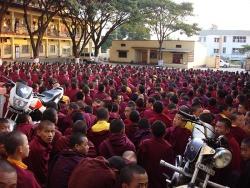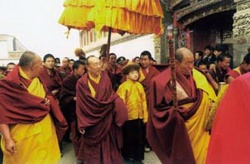Unveiling the Mysterious Tibetan History
I was born in January 1937. My father was steeped in the Tibetan language, astronomy and astrology, exerting deep influence on my future. Unfortunately, he died when I was very young. I studied in a private school at eight, and studied Tibetan grammar from the Living Buddha Kezhub at 14. When I was 16 years old, I studied in the Moinzekang (Tibetan Medicine Hospital), where I was taught the Four-Volume Medical Code together with some 60 others. In 1955,1 worked for the Cadre School of the PLA Tibet Military Area. The year of 1956 turned out to be a landmark in my life. I was working as a waiter in the hostel of the Preparatory Committee for the Founding of the Tibet Autonomous Region, and had the opportunity to meet Vice-Premier Chen Yi. Later on, I worked for the Secretariat of the Communist Youth League Work Committee, attended the First Youth Congress of Tibet, visited inland China, and studied in the Beijing School of the Central Committee of the Communist Youth League.
Beginning in 1958 I taught in the Tibet Communist Youth League School in Xianyang, Shaanxi Province. Later on, I was transferred to teach in the Tibet Pub-lic School, where I compiled teaching materials until 1963.
I returned to Tibet in 1963, working in the Tibet Archives. During this period of time, I read many books and studied Tibetan history. No matter how the environ-ment changed, I never gave up studying. In 1978, the year the reform and opening program was introduced in China, I became director of the History and Culture Research Institute of the Tibet Teach-ers' Institute, majoring in the study of King Gesar song epic, and the Dege Sutra Printing House. Later on, I served as chief of the Publicity Department of Tibet University and concurrently di-rector of the Marxism-Leninism Teaching Research Institute of Tibet University, beginning to compile General Outline of the Tibet Autonomous Region which came off the press in De-cember 1981. Four years later, I published Mirror on the History of Tibet which has been adopted as teaching material by seven universities.
In 1985,1 was promoted to be deputy director of the Compilation and Translation Bureau of the Tibet Autonomous Region, and deputy secretary general of the CPPCC Tibet Committee in 1986. During this period, I met many people and compiled the Chronology of Tibetan History (published in 1987 and reprinted four times), Rada Event and Its Nature (published in 1991), and 300 Poems of the Tang Dynasty (translated from Chinese into Tibetan). In 1990,1 compiled and wrote the section on modern times of the General History of Tibet (in Chinese) which won the National Book Award in China. Given my achievements, I became somewhat famous in the social science field in Tibet. In 1992, I was appointed president of the Tibet Academy of Social Sciences.
In 1997,1 developed a strong interest in the Bon religion, which was in vogue during the Tubo period.
According to statistics available to me, the Bon religion has been in existence in Tibet for over 4,500 years. Under the impact of "the conflict between Bon and Buddhism," only a small number of eminent monks study the Bon religion today. There are few study materials.
Confucius was said to be one of the nine scholars steeped in the Bon religion. According to records on the Bon religion, the Tibetans and Han Chinese have been in contact for 1,000 years earlier than is generally believed..
In 1998 my assistants, Cedain Gyiabo, and I surveyed the area where the Bon religion is still influential, and found 92 monasteries belong to it. They include 54 in Qamdo, 28 in Nagqu, six in Xigaze, two in Nyingchi, one in Ngari and one in Lhasa. Nowadays, there are 3,291 Bon monks, 93 Bon Living Buddhas, and 130,000 followers. During the survey, we took large numbers of photos. On this basis, we published Records on the Bon Monasteries and History of the Development of the Bon Religion.
In July 1998, when the 8th Session of the International Conference on Tibetan Studies was held in the American state of Indiana, I was invited to present my treatise entitled The Meaning of Bon. I was selected as a council member of the International Association of Tibetan Studies on behalf of China.
In August 1999,1 attended an international seminar on the Bon religion. This gave me a chance to conduct exchanges in this regard with international counterparts.
In a nutshell, I have produced over 800,000 words of works in both Tibetan and Chinese. Honor-ing the achievements I have made in studying the Bon religion, the Central Government department concerned granted me the title of "State-Class Expert" eligible for special government allowances. However, I understand I still have a long way to go before I can make still greater contribution to the study of the Bon religion.
(Recorded by Dorje Zhamdui and Xue Wenxian)

